In the comments section of this post, I’d like you to share your recording of the BBC Midwinter Broadcast to Antarctica!
In years past, I’ve created a post with all of the Midwinter recordings curated in one article. This usually takes me 12+ hours to prepare over a couple of weeks as many of the audio clips and video recordings must be formatted for the site and embedded. There is also a lot of discussions back/forth confirming details with listeners. This year once again, my schedule is such that if I try to piece one of these articles together I might not have it published for many, many weeks.
The past two years, this format worked brilliantly, so we’re doing it again…
Time and frequencies
Our intrepid contributor, Richard Langley, reports:
According to a posting on Glenn Hauser’s World of Radio IO group, the following frequencies are confirmed for the broadcast on 21 June 2023 [at 21:30 UTC]:
-
- 7255 kHz Dhabbaya 250 kW
- 12005 kHz Woofferton 300 kW
- 13810 kHz Woofferton 250 kW
(Ascension relay – not being used)
Please comment with your recording on this post!
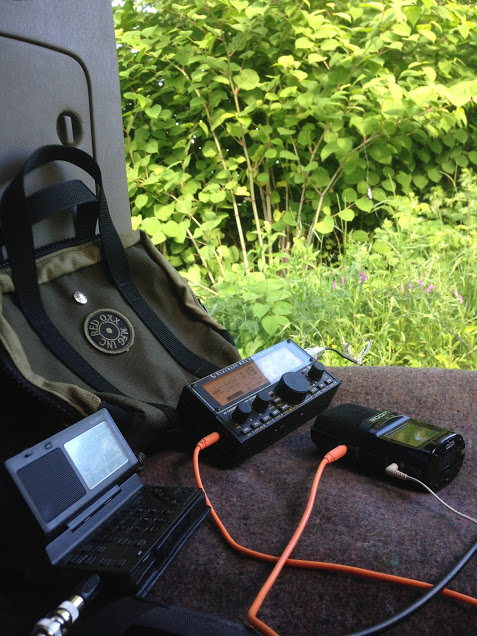
Listening to the 2017 BBC Antarctic Midwinter Broadcast from the back of my vehicle in Saint-Anne-de-Beaupré, Québec, Canada.
I’ve created this dedicated post where you can comment and include links to audio and video of your 2023 Midwinter Broadcast recordings. This will allow you to post your logs and recordings at your convenience without my availability becoming the bottleneck.
Here’s the format I’d like you to leave in your comment of this post:
Name:
Listening location:
Notes: (Include frequencies and any details about your receiver and antenna.)
Link to audio or video: (YouTube, Vimeo, Internet Archive, SoundCloud, etc.)
Video and Audio Recordings
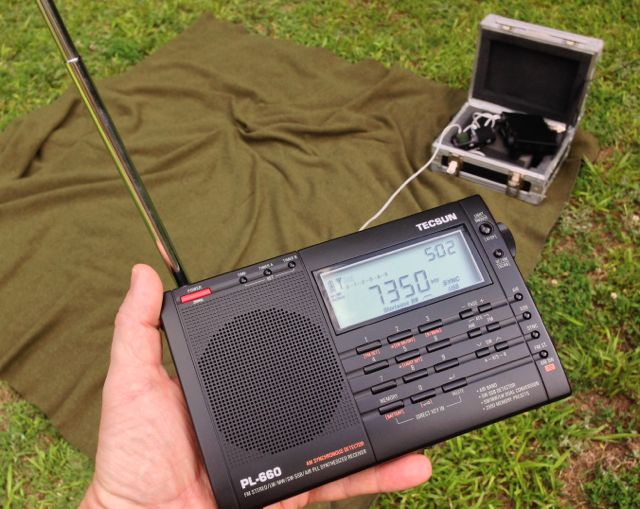 There is no way to directly upload audio in your comments, however, you can link to the recordings if you upload them to the Internet Archive (which I’d highly recommend) or any of the video streaming services like YouTube and Vimeo–or audio services like SoundCloud.
There is no way to directly upload audio in your comments, however, you can link to the recordings if you upload them to the Internet Archive (which I’d highly recommend) or any of the video streaming services like YouTube and Vimeo–or audio services like SoundCloud.
If you have a photo you’d like to include in your comment, send me an email from the same address you used in your comment. I’ll manually post the image at the top of your comment when time allows.
As with each year, I’ll make sure the BAS team and the BBC receive a link with all of your recordings!

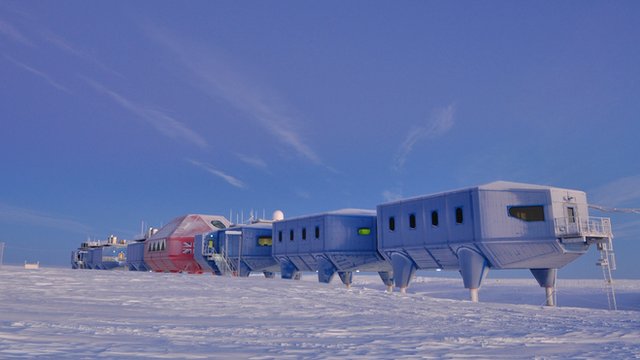
Listen at the end of the world, in the city of Punta Arenas, South America. Vertical antenna and an ICOM IC-718. Already without sun on this day of the winter solstice, being 21:30 UTC, 18:30 local.
Posting this on behalf of Giuseppe Morle:
https://youtu.be/3be8jiAjTuo
Dear Thomas,
I’m Giuseppe Morle’, iz0gzw, from Formia, central Italy on the Tyrrhenian Sea…
This is my contribution regarding the BBC Antarctic Midwinter 2023…
I listened well to all frequencies from Dhabbaya and Woofferton from my shack…
even with the Tecsun H501 and its telescopic stylus I was able to hear the transmission well on all frequencies…
Thank you for what you do for the SWLing Post community…
I wish you a good summer.
?
73. Giuseppe Morle’ iz0gzw
Here’s my contribution! First time participating
Name: David – EA3IEK (SWL callsign: EA4998URE)
Listening location: S’Agaró Beach (Girona, north of Barcelona, Spain). “Pedestrian mobile”, sitting at the beachside promenade, right by the sand!
Notes: I decided to try out my luck and listen to (and record) the Midwinter Broadcast on 13810kHz, which ended up having been a great decision, as the signal stayed full-scale, and with a clear and strong modulation, almost for the entirety of the time until QRT! Receiver: Tecsun PL-660 / Antenna: Telescopic / Audio recorder: Tascam DR-05 (WAV 44.1kHz/16 bit).
Link to audio or video: https://soundcloud.com/user-428055842-229606565/ea3iek-ea4998ure-iss-ariss-contact-nick-hague-145800mhz-doppler-1304ut-06082019?si=9e0bd53f04764f20a4dafcf052d545d3&utm_source=clipboard&utm_medium=text&utm_campaign=social_sharing
Just noticed the link I provided doesn’t point to the correct recording! Many apologies for that! The actual link is as follows:
https://soundcloud.com/user-428055842-229606565/ea3iek-ea4998ure-bbc-midwinter-broadcast-2023-13810khz-2130ut-062123?si=e702e6cc09a34bfe87ea061943c19538&utm_source=clipboard&utm_medium=text&utm_campaign=social_sharing
73!
As usual, I recorded the complete broadcast and have uploaded it to the Shortwave Radio Audio Archive here:
https://shortwavearchive.com/archive/bbc-world-service-annual-antarctic-midwinter-broadcast-june-21-2023
Here is the text of the archived item:
A live, off-air, half-hour recording of the BBC World Service special Antarctic Midwinter Broadcast on 21 June 2023 beginning at 21:30 UTC. The broadcast, hosted by Cerys Matthews, featured messages and music for the 37 members of the staff of the British Antarctic Survey (BAS) overwintering in Antarctica at the Rothera (Antarctic Peninsula) and King Edward Point and Bird Island (South Georgia) research stations. In addition to personal messages from family and friends, there were interviews withProfessor Dame Jane Francis, Director of BAS and Nadia Frontier, a marine biologist from BAS and former winterer. The transmitter came on the air with a test tone (1108 Hz plus harmonics) about a minute before the program started. As sometimes happens, the first few words of the introduction were missed.
The recording is of the transmission first on a frequency of 12005 kHz but after a few minutes it was switched to 13810 kHz due to interference (QRM) on the former frequency. Both frequencies were from the BBC’s Woofferton, England, transmitting station. The sender of the 12005 kHz frequency had a registered power of 300 kW with antenna beam 182 degrees, while that for 13810 kHz was registered as 250 kW with an antenna beam of180 degrees. The transmission was received on a Tecsun PL-880 receiver with a Tecsun AN-03L 7-metre wire antenna outdoors in Hanwell (just outside Fredericton), New Brunswick, Canada, in AM mode with 2.3 kHz RF filtering. Reception on 13810 kHz was quite good with little noise or fading and very good signal strength. The additional parallel frequency of 7255 kHz from Dhabbaya, United Arab Emirates was not heard.
Hi here I have two short recordings of the BBC Midwinter broadcast.
https://youtu.be/jnI1MANW9R4
https://youtu.be/yWFTID4QoVg
https://youtu.be/nFEEd3b0IuM
All the Catches were done with the same long wire antenna of 10 meters, in Santiago of Chile
What a delight to listen to and record this year’s BBC Mid-Winter Antarctic broadcast. Here’s my link of the latter half of the broadcast:
https://www.dropbox.com/l/scl/AACcdtPq9Cb3q2k0R_sI1uirZ0xVoqEKG8w
This was recorded on my cell-phone, connecting to my Masset, BC, CANADA KiwiSDR fed by a 450′ North Beverage. I was thrilled with the great reception this year thanks to the use of higher frequencies. 13810 was also audible, but not nearly as strong as 12005 which was pegging the meter at S9+10. I was parked in Ladysmith, BC on our way back from Masset via BC Ferries (a 3 day trip each way).
Our public KiwiSDR is found at Haida.DXer.CA.
All three frequencies made it into Marahau, New Zealand in 2023, at varying signal levels. I recorded all using my own home-based KiwiSDRs and shared Wellbrook loop antenna. Recordings are currently up on my Dropbox account: https://tinyurl.com/yc5hdbth
Recording in Voronezh region, Russia
Location: Luxembourg / Contern – JN39CN
Notes: PAC12, RSPDuo, SDRUno.
Listened on both frequencies: 13810 kHz and 12005 kHz. Good reception on each frequency.
It’s been a great pleasure listening to this transmission – and wishing all the people at the southernmost part of the earth a funny dark winter 🙂
And here is one of the recordings:
Caro Thomas e Amici di SWLingPost,
sono Giuseppe Morlè, iz0gzw, da Formia, centro Italia sul mar Tirreno…
ho ascoltato il BBCAntartic Midwinter 2023 sulle 3 frequenze segnalate con buon livello audio e segnale con i miei ricevitori vintage della mia stazione…
su 7255 forse fading continuo ma comprensibile…
ho provato anche con Tecsun H501 e il suo stilo telescopico sul balcone di casa con risultati buoni…
su questo link potete vedere i risultati di questo evento annuale…
https://youtu.be/3be8jiAjTuo
Grazie a Tutti Voi e buon ascolto.
73. Giuseppe iz0gzw.
Hi Thomas, I am pleased to send you three audio clips relating to the BBC’s Mid Winter time program. The three clips, lasting about 1 minute, were made according to the following criteria:
13810 kHz from 2132 to 2137 UTC (Best reception)
12005 kHz from 2138 to 2143 UTC
7255 kHz from 2145 to 2150 UTC
I hope the recordings help. I would like to know if on this occasion there is the possibility of receiving a special QSL card, albeit an eQSL and what is the email address to send the listening report too.
Until next time and all the best possible.
Giovanni, IT9TZZ
Location: Columbus, GA USA. Used RSPdx SDR for receiver with a 4-band ground-mounted trap vertical (Hustler 4BTV). I heard the broadcast on both 12.005 and 13.810 but 13.810 was slightly better, varying between S6 and S9. The broadcast was the strongest towards the end. The 7.255 freq. was way too noisy at my location due to thunderstorms in the region. Unfortunately I failed to get a recording. Thanks for the alert. I was not able to hear them last year.
Hi. Sorry, I don’t have a recording but at 13810 kHz it was really clear reception here in Helsinki, Finland. SINPO: 45433. “I’m a believer” by Monkees & messages from home. And marvellous to hear that someone’s wishlist contained Käärijä’s Cha Cha Cha!!! Also Led Zeppelin’s Immigration Song was played.
Radio: Tecsun PL-330
Antenna: homebrew loop on the balcony
Name: David – G4EDR
Listening location: Filey, UK
Notes: RX, Sangean ATS-909-X2. Antenna, 20 metre long wire. 12005 kHz was the best frequency for me with a good strong signal, no interference and little fading. 13810 kHz was a little weaker and suffered from some interference (possibly generated locally). 7255 kHz was unreadable.
Link to audio or video: https://youtu.be/Yoff6ru_Lrc
Hi there.
As a former Merchant Marine Radio Officer the broadcast brought fond memories of my sea days.
Unfortunately I live in downtown Buenos Aires and the noise levels are staggering.
Receiver: RSPDuo along with SDR Console
Antenna: 40 ft. Long Wire + 9:1 homemade balun, sloping NE-SW
Frequency: 12005 SIO323 all along the broadcast.
13810 Carrier detected, no audio.
7225 NIL
Donned headphones and able to read most of the programme.
Looking forward to next year broadcast and hopefully in better conditions.
Best regards
Waldo LU/CX2AD (Buenos Aires – Argentina)
Name: Ollie (13dka)
Listening location: North Sea coast S of Danish border
RX: Belka v3 w/ whip
Notes:
– 7255 kHz very weak, directional antenna seems to work fine (signal was apparently picked up fine in South Africa), some co-channel interference from another station (maybe 2, I heard Arabic language).
– Woofferton might still be audible over here when they disconnect their antennas. 🙂
Link to audio or video:
https://www.youtube.com/watch?v=xz5X4uDSlvo
Switching frequencies in roughly 1-minute intervals (check text overlay for what is what), showing first 5 minutes of the broadcast in the video (well, still image).
https://youtu.be/IW2xk299gCs
Frequency 13810 khz.
The place of reception is the City of St. Petersburg, Russia.
The equipment is a XIEGU G-90 HF transceiver and a marconi antenna on the roof at the house in the center of the city.
Good reception from Woofferton here in NE Poland (QTH KO12jr), an easy feat for SW, on a rather makeshift 3-element Quad antenna I actually built for FM DX – however, the three loops were made out of RG58 cable, and the driven element is specifically a shielded loop… and over the course of listening to the broadcast I was really impressed with this antenna’s performance. Lots of good DX I found later on an IQ recording I’ve been making concurrently 🙂
The rig was Airspy HF+ Discovery SDR. Signal on 12005 kHz was blowtorch for the 1st minute or two (~70dB SNR) but weakened soon thereafter. It remained quite steady at 55-60dB SNR, however, so still a good reception overall.
Audio or video recording: in fact, I was streaming the show; the recording is @ https://www.youtube.com/watch?v=MaZxjbxJWdY ; the 12005 kHz audio starts at 12:31.
Haven’t checked other frequencies but I’ve been actively checking them during the test a week ago: https://www.youtube.com/watch?v=Yz8CPuowejM
Of those, 13810 was actually slightly better then than 12005, but I think there wasn’t much difference to worry about yesterday 🙂 12065 was OK too. 7255 was a complete disaster – all the worst of shortwave in one place: weak signal, off-frequency, and clashing with another station (Xizang PBS Tibetan service) on the same frequency.
The only disappointment of the evening was how my laptop performance degraded when battery level reached 25%… even though Windows battery saving mode isn’t supposed to kick in until it gets to 20% ????
My two cents on reception in Lithuania:
https://archive.org/details/20230621-2130Z-12005khz-bbc-midwinter-antarctic-special
https://archive.org/details/20230621-2130z-13810khz-bbc-midwinter-antarctic-special
“I’m a believer”.
“Hope you’re having loads of fun out there, not getting too drunk tonight. All our love.”
– Listening location: western Germany, indoors (north-facing window worked best)
– Receiver: “Belka” (v3) with the stock 75cm telescopic antenna and a long wire counterpoise
I listened mainly on 13810 kHz, which worked pretty well (55444). The signal on 12005 kHz was just as clear, but on 7255 kHz I received practically nothing.
Here is a video recording at 13810 kHz, including the end of the program: https://youtu.be/pqMcn5Nz86k
Looking forward to catching the broadcast next year again!
Andre in Johannesburg, South Africa. Received the 7255 kHz signal, average to good reception. On Kenwood R1000 with MLA30+ loop antenna. No reception whatsoever on XHDATA D-109 with its built-in antenna. Received the 12005 kHz signal from Woofferton very weakly on the Kenwood. No reception on 13810 kHz. Fun programme to listen to. Ended with Jingle Bells, it is in my recording.
Link: https://youtu.be/TZHx28I7DTE
Hi, also this year I listened to the BBC Midwinter Broadcast in Antarctica on 21/06/2023 at 21:30 utc.
I listened to the broadcast on all three frequencies.7255kHz
12005kHz and 13810kHz.
I am writing to you from Italy and precisely from the province of Salerno
For listening I used an Afedri Sdr Lan IQ receiver and as an antenna I used a Wellbrook Ala 1530.
This is the youtube link of reception on all 3 frequencies.
https://www.youtube.com/watch?v=BMdnpU5GaUg
A warm greeting to all of you from Italy
Gabriele Somma
Andre in Johannesburg, South Africa. I used the Kenwood R1000 with MLA30+ loop antenna. Average to good reception, only managed to receive 7255 kHz. The signal on 12005 kHz was extremely weak, and 13810 kHz did not come through at all. Quirky and fun programme to listen to. I liked the end with Jingle Bells! It can be heard in my recording.
Link: https://youtu.be/TZHx28I7DTE
Name: Ralf Bender
Listening location: Germany, JO40BT
Notes: Sangean ATS-909X2 and a Wellbrook antenna, all frequencies
Link to audio or video: Full reception video on YT: https://youtu.be/gpf2ahFu8N8
Happy Birthday Thomas!
Name: Michael De Cos
Listening location: Clifton, New Jersey, USA
Notes: I listened to the broadcast on 12005 KHz on my Eton Elite Executive receiver. I attached an XHDATA AN-80 wire antenna to the external jack.
Link to YouTube video: https://www.youtube.com/watch?v=YIlr422GX4g
Host: “Describe some of the smells, …..?”
Scientist: “Penguin feces!”
TomL location at Campton Hills Forest Preserve, St. Charles IL.
21:30-22:00 UTC, 13810 kHz, SINPO 55444. Strong but variable signal peaking at S9+30 dB with distant thunderstorm crashes in the background.
3-conductor Folded Loop-on-Ground antenna, Wellbrook Medium Aperture Preamp, CrossCountry Wireless Preselector, SDRPlay RSP2, SDR Console 3.2, Lenovo X270 laptop.
Link to my recording:
https://archive.org/details/230621-antarctic-mid-winter-bbc-2023
TomL’s station:
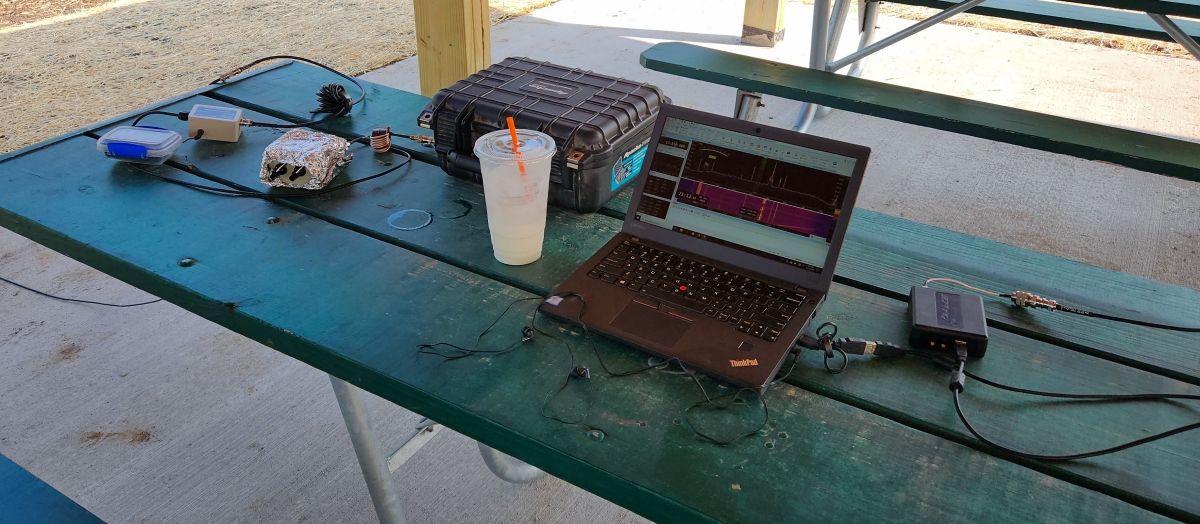
A fantastic broadcast with magnificent reception at my QTH. Decided to use my yaesu ft1000mp mkv field as it has synchronous reception, it was 5 to 10 over S9 with almost no fading at all. Antennas used were emcom III 130 End fed LW running ne sw and an extended double Zepp for 20 meters, that has an east-west pattern . The frequency chosen was 13810mhz. Over all a very enjoyable listening experience .
William, KR8L
Illinois, EM57pe
Mostly monitored 13810 but switched to 12005 a time or two, plus tried various modes and bandwidths, as you will hear me switching around a bit. Finally settled on ECSS-U and 4.5 kHz. 12005 was actually a bit stronger but had more noise so I stayed on 13810 for most of the time, especially the last 20 minutes. Signal strength seemed to improve a bit in the last 15 minutes.
Recorded with my AirSpy HF+ Discovery and SDR Console v. 3. Antenna is a Butternut HF9V
Link: https://drive.google.com/file/d/1l76myM5X5TJa_EJQ4T-IR5z0IvgM5bRk/view?usp=sharing
File is on my Google Drive, may be able to play it directly from there or may have to download.
(Playback on the BBC website is now available: https://www.bbc.co.uk/sounds/play/w3ct5hqt)
Repost as the first one didn’t seem to get up.
Dave in Ottawa, Canada
Belka DX receiver with 75 feet total length loop-on-ground antenna (signal was audible using the supplied telescopic antenna but a significantly stronger and less noisy signal was produced by the LoG). Audio out from headphone jack to Zoom H1 recorder. No audio processing.
7255kHz: no reception.
12005kHz, 13810kHz: good signal.
Link to audio or video (Dropbox, click past/decline the initial sign up box):
12005 Wooferton signal
https://www.dropbox.com/scl/fi/b7n3wsvuf0x15qquvce1z/12005_WOF_230621.flac?dl=0&rlkey=029b19mia6ep71gs8g8leebrt
13810 Wooferton
https://www.dropbox.com/scl/fi/smoah59wuvwosvlf6hoef/13810_WOF_230621.flac?dl=0&rlkey=sbtou9l0e0go5v6fpxrr19yuv
Name: Tony Pavick
Listening location: Hope BC Canada (CN99GJ)
Notes: 12005 khz using Eton Elite 750 with MLA 30 + loop. Reception was a bit rough and only showed a small amount of improvement over the half hour. Tone at about 2128:30 UT and programme start at 2130. Voices indistinct but the Monkees song “I’m a Believer” clearly heard at 2133. Cross-verified against an SDR in Spain. Clip is of 2 minutes at about 2132:30 UT
Link to audio or video: https://twitter.com/PopShopRadio1/status/1671644984150487040
Name: Michael De Cos
Listening location: Clifton, New Jersey, USA
Notes: I listened to the broadcast on 12005 KHz. I used my Eton Elite Executive receiver with the XHDATA AN-80 wire antenna attached to the external jack.
Link to audio or video: https://www.youtube.com/watch?v=YIlr422GX4g
TVRadio1972 is my YouTube channel.
Name: John Zachary Alvarez
Listening location: Cavite, Philippines
Notes: I was using the Sihuadon (XHDATA) D-808 receiver and the XHDATA AN-80 external antenna to monitoring the special broadcast on 13810 kHz (via Woofferton) earlier but the signal reception in my area was “weak signal”.
Link to audio or video: https://youtu.be/nXOvdP0wzMI
Great reception in northern Florida, USA on 12005 kHz. Fair reception on 13810 kHz.
Receiver: Airspy HF+ SDR
Antenna: 95 foot doublet antenna @ 30 feet AGL
https://on.soundcloud.com/8cao4
I heard the midwinter broadcast on the BBC broadcast on 12005,Woofferton, on an Airspy HF and a 40 m skyloop antenna here in Denver, Colorado. Reception was amazingly clear. A quirky, fun, sentimental broadcast. Unfortunately my recordings were unsuccessful. Thanks for making me aware of this gem.
I had an antenna oriented exactly the wrong way for this, in Loveland CO. Terrible conditions, while listening the wrong way!
Too bad about not getting a recording. Listening to others suggest really good reception.
Reception in VA on 12005.0 and 13810.0 were both excellent here. Used a WinRadio G33DDC Excalibur Pro with a back-fed sloper for 12 mhz and a Yaesu FTdx-101MP and an M2 4el on a 50′ boom @ 110ft 20M Mono Bander for 13 mhz. It was like listening to FM on 13 mhz!
Chuck Rippel
DX’ing from the shore of The GreatDismal Swamp
Here is the link to my 12 mhz audio:
https://www.dropbox.com/s/xutowqkqlyxu9zb/BBC-Ant-12.005MHz_23-06-21_17%2730%2705.wav?dl=0
Dan Jakubowski
Macedonia, Ohio USA
Listening on an Eton Elite 750 on 12005 Khz with an end fed long wire(45′) antenna mounted in the attic. Strong signal. SINPO: 55544.
https://drive.google.com/file/d/1G4gd05qv9OisCGc0AxUAiUOAtXov6Tr8/view?usp=drivesdk
https://drive.google.com/file/d/1G7cDK5BvRbxnqCVUPRgV0vxaY8GCOcQy/view?usp=drivesdk
Reception on SDRs in the DC/MD/VA area is quite good on 12005 from carrier on just before 2130 UTC. We have significant storm and band noise in the area. Used a Eton Elite Satellit for this reception located indoors, and had to hold the telescopic whip on the receiver to obtain listenable level and lower noise. Frequency: 12,005 khz https://youtube.com/shorts/uO49mERyaP0?feature=share
Dan Jakubowski
Macedonia, Ohio
12005 Khz
I’m listening on a Eton Elite 750 using an end fed long wire(45′) running north-south in my attic.
SINPO: 55544
https://drive.google.com/file/d/1G4gd05qv9OisCGc0AxUAiUOAtXov6Tr8/view?usp=drivesdk
Name: Ken Litzke
Listening location: Ballston Lake NY
Notes: Heard the broadcast on 12005 and 13810. Using Grundig Satellit 800 and MLA-30 Loop Antenna
Link to audio or video: https://archive.org/details/img-2885_202306
Ken,
Perhaps you would like to tune into the Radio Monitoring Net, Tuesday nights, 7 pm. on 146.94, Troy, NY
Cheers, Jock
Thanks Jock, I’ll give it a try on Tuesday night.
Ken
Receiver: Tecsun PL-660
Antenna: longwire
QTH: Ciudad de la Costa – Uruguay, South America
https://youtu.be/1fApow7gCIE
Pressed send too soon:
Please combine these messages:
Link: https://www.pinewood-wireless.net/bbc-20230621_212817.wav
https://youtube.com/shorts/Tq_54hBv9s8?feature=share
Receiver used: Kenwood R-5000
Location: Southwest Rocks Mid North Coast of NSW Australia
https://youtu.be/wAxOVZr2Ka0
Name: Dave Kingsborough
Listening location: Harrisburg PA USA
June 21 6 PM EDT. Listening with a Tecsun PL-330 radio with built-in whip antenna. Listened on 12005 kHz and 13810 kHz . 12005 was better.
There was a lot of fading and qrn since we have a storm coming in our direction.
I recorded this program segment as it went off the air
Link to YouTube: https://youtu.be/XkcwEprSl_U
Dave’s station:
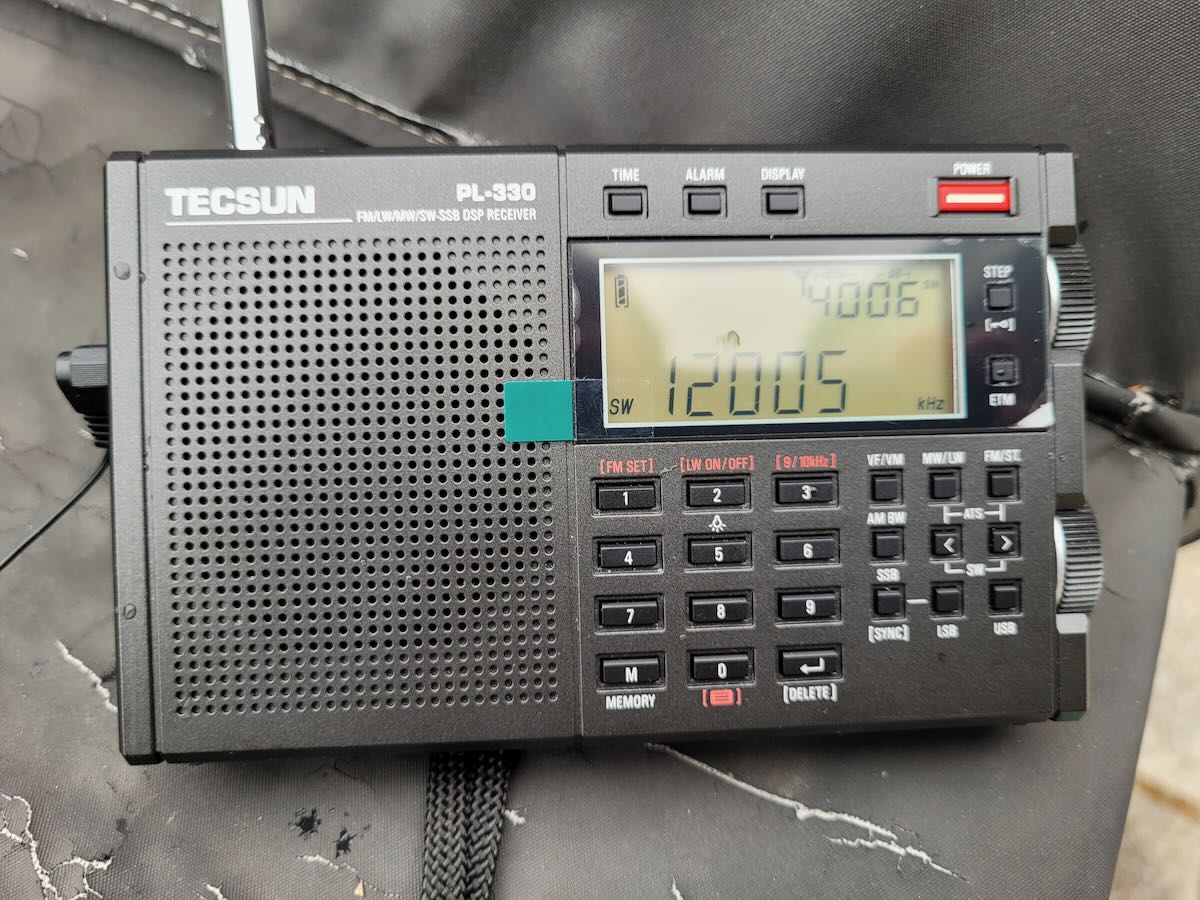
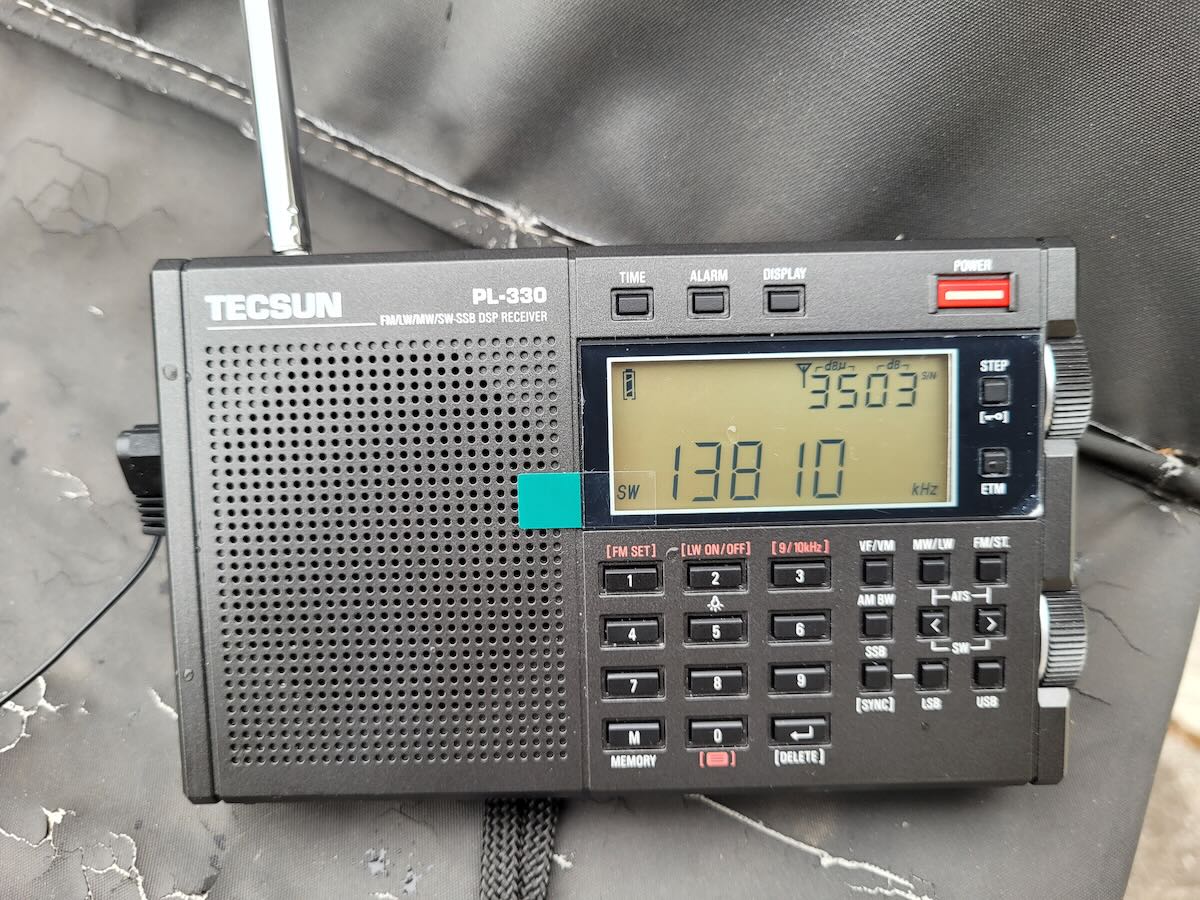
Forgot to add, antenna used was an EWE orientated to the NE
You must be about as far from Wooferton as Antarctica!
Location: 40.37 N latitude, 105.28 W longitude (Maidenhead DN70ii)
Recording start: 21.29 UTC as soon as test tone heard on 12.005
Recording:: Started on 12.005, switched to 13.810 (carrier detected, no legible audio), switched to 7.225 (heavy QRN and QRM, no signal detected), back to 12.005.
Audio of voices detected, Music heard (I’m A Believer) further voices. Sounded like a musical analysis program.
Receiver: ICOM IC-7300
Antenna: terminated, tilted folded dipole, 93 feet long, oriented for maximum sensitivity to the east and west.
Near Venice Italy, radio Receiver Tecsun Pl 660 with telescopic antenna https://youtube.com/shorts/F-RsHlcLdR0?feature=share
Broadcast was 20db over S9 here in New Hampshire on 13.810 mHz.
Thanks for posting the info.